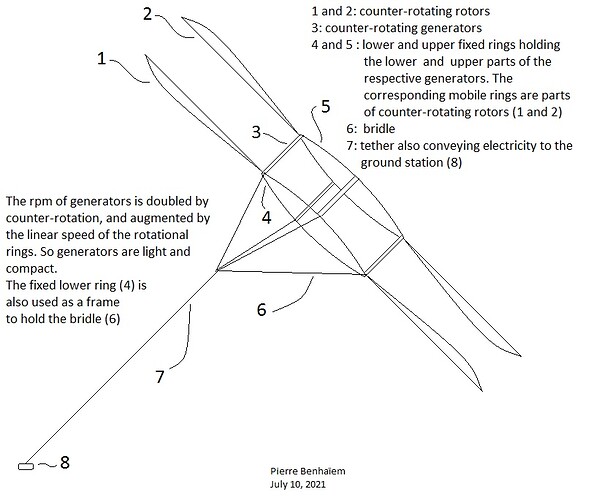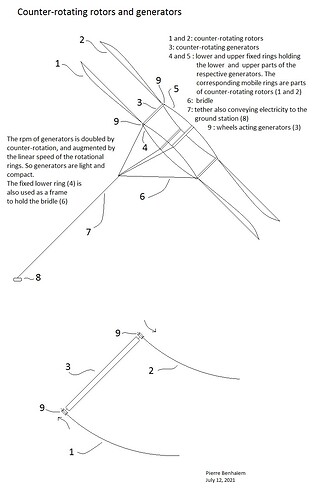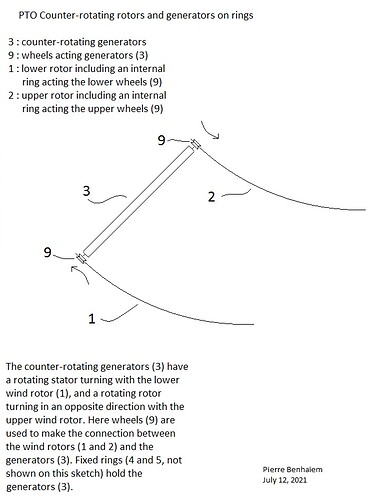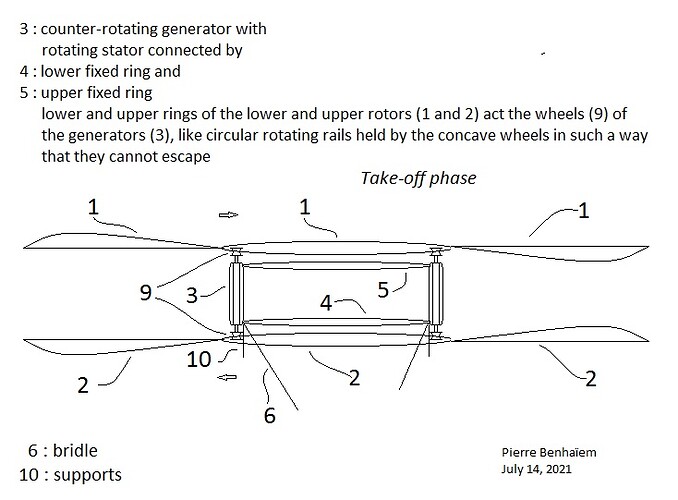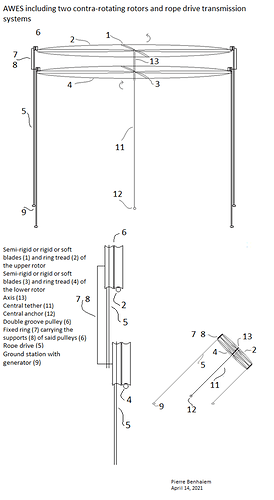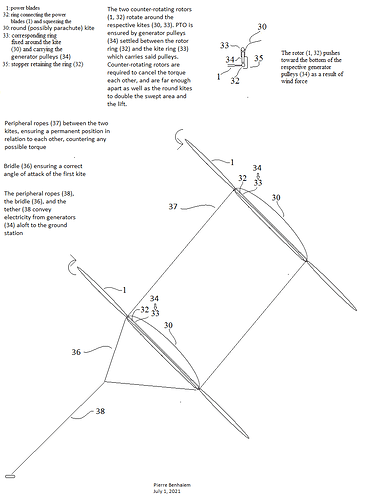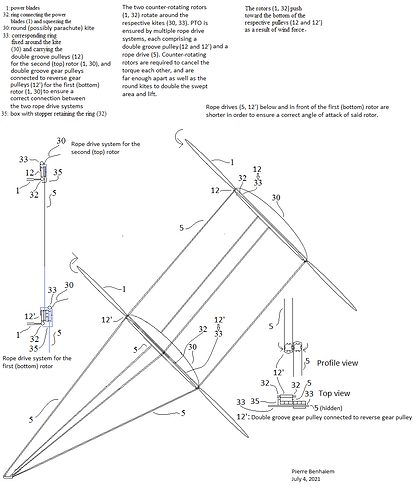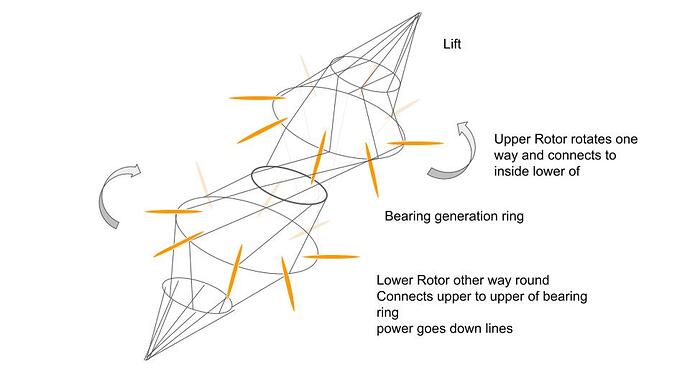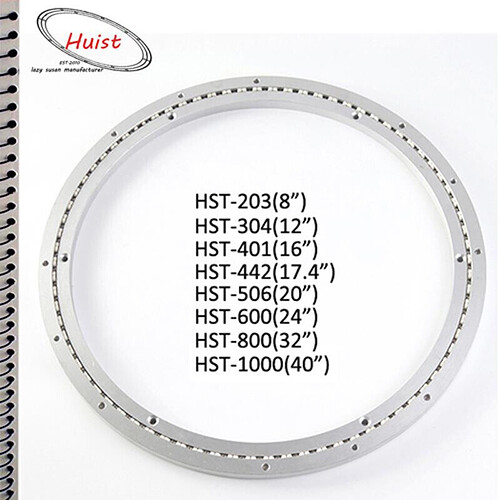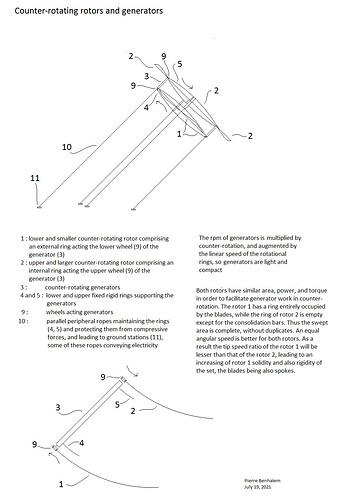I evoked Dr. Beaujean's airborne wind turbine in the aim of a preliminary study. Since many things have become clearer. IMHO the end of Makani is a probable sign of that of all current utility-scale projects, none allowing to maximize space, none having sufficient security potential, or quite simply none being operational and productive at any altitude.
I think this design can be a key towards some AWE viability, gathering the following features: a motionless frame as the stator connected to the ground by numerous motionless tethers; numerous blades as the rotor going fast thanks to the hollowed out stator.
As a possible result there is no limits for the scalability, the numerous motionless tethers add a higher level of both safety and control, and a single unity could advantageously replace a farm of kites with their erratic motions and ways of generation leading to a far larger space use.
IMHO Dr. Beaujean is the only one conceptor in AWES who understood the main issues for a possibility of AWE success.
beaujean WindTech Nov-Dec 2011 compressé.pdf (1.2 MB), SkySailsforWindTurbines2012.pdf (265.3 KB)
Some secondary remarks: I would like to avoid counter-rotating blades as that adds complexity and risk of collision. Perhaps the anchored tethers can partially prevent too much torsion due to the torque of the simple (not counter-rotating) rotor. If no, a ring like for Daisy could be added to minimize tethers torsion.
The problem is the requirement of the implementation of moving suspension lines for the two rigid rotor rings, leading to a difficult control for the alignment of the rotors, then shear forces due to wind variations, and also higher tethers drag.
A collaborative project around this project gathering companies and players could be the last hope for AWE. Beside it of course the same actors could pursue their current R&D in the aim of some commercial niche.
If you’re interested in this, I’d try to reduce the concept down to it’s bare essentials, and decide on the size you want to build it. Now it looks like a multibillion euro project, try to see if you can make the most important concept in the idea for a hundred or a thousand euros first.
I think this concept could be feasible and perhaps interesting in small dimensions, about 2-5 m span, using blades of something like 0.2-0.5 m. If a counter-rotating rotor is used, the tethers can be as long as wished. If no, the tethers should be short (after all in the same proportions as the planned AWES) in order to counter the rotor torque, undergoing a limited twist.
Below are some sketches about a counter-rotating bi-rotor as for Beaujean’s AWES. As the diameter of the rings where the power is taken is about 1/3 the rotor diameter, the linear speed could be about 20 m/s. These speed is doubled if we built and use counter-rotating high speed generators. The fixed rings hold the generators and are used as a frame for the bridle. I don’t think this can scale a lot until some means are found in order to replace rigid parts used for PTO (power take-off) with tensile elements. I thought about a central parachute (sketches below) but the rigidity could be too low to allow the rotor(s) rotate around it.
Counter-rotating bi-rotor:
More details on the following sketches:
The high speed generators could be replaced with rope drive systems
(in the following sketch the PTO is represented at the periphery of the rings, leading to more weight):
Counter-rotating distant rotors around their respective central fixed parachute kites:
PTO with high speed generators:
PTO with rope drive systems:
Think of all of these sketches as drafts in order to come toward with something doable and scalable.
1 Like
When power take-off (PTO) is taken onboard aloft, by generators or rope drive systems, it looks to not be possible to avoid the implementation of counter-rotating rotor system. Indeed if only one rotor is implemented, even if tethers are spaced and short in order to counter the torque, some power is wasted to maintain the twist of said tethers.
Just a comment
I like the idea of what this topic is trying to do.
Sharing data and Challenging us all to see how we can best contribute to solving an AWES puzzle.
Some of the most successful science of recent years has worked like that… Alpha fold the AI protein folding algorithm development came from a similar challenge. Covid data was shared very early…
For me the most challenging aspect of this design will be the material choices for the rail interface between the rings and the bands themselves having to turn so fast on a small diameter under tension
A twin solid ring band design set between the wing levels might be better…
The upper ring being turned by the lower kites interfaces to the lower ring turned by the higher kites… That could maybe hold the speed and generation gear…
Is that clear or should I draw?
The bearing generation ring being something like a Lazy Su table bearing A slim version of a big yaw bearing…
It’s likely to be heavy I’d guess with all that generating and bearing mass in the air being compressed, electrically active and running dynamically
1 Like
Very interesting: a sort of counter-rotating Daisy that could be stacked indefinitely.
The weight of the HST-1000 (1 m diameter) alone is 14.6 lbs (so 6.6 kg).
Surely not indefinite stacking
The generation would depend on lift tension from the top rotor which already has to support the mass of the bearing. And this is only a small bearing already… And the bearing has to be configured for axial thrust compression.
Like always, I prefer a smallest possible ball bearing. In this case that would mean a small bearing at the center, then extend the arms by eg. a carbon composite star or n-gon or something similar. Though I dont feel this direction holds much potential. There are more problems related to handling and oscillations of the stack. This will escalate with more mass at each «floor».
I think right now its not a matter of cooperation rather just keep hacking away at concepts to find one that could work. Once such a viable concept is uncovered, Im sure people will throw themselves at it.
Just to be clear - i believe a single person will be most influential in making AWE happen, but I also think that person will not do so in a vacuum. Rather it will be on the shoulders of people like us here on the forums, academic research and other project’s experience. We are already at the point where it is difficult for a single person to digest all information about AWE. So by extending that, and assuming AWE will eventually happen, some of that existing information is probably useless/outdated.
Indeed, in current wind power, the power take-off (PTO) axis would correspond to a small-diameter ball bearing.
But when the diameter of the rotor increases the generator rpm decreases while the linear speed remains low (corresponding to the diameter of the generator), leading to the implementation of a heavier generator. This is not a problem for wind power until the larger dimensions come, leading to Sway attempt for a larger annular generator which increases the linear speed. But weight is a crucial concern for flygen AWES.
We can consider Beaujean’ system as giant 1350 m diameter rotors whose power take-off is taken at the periphery. The designer was aware of the problem. If a central PTO shaft was designed like for current wind turbines, the generator would be far too slow and too heavy, resulting in a large and heavy gear.
The construction of a large annular generator can be too difficult. So I propose using large rings acting several small high speed generators.
If it is possible to set up a large ring by using a light construction, one can benefit from high speed generators (around 6000 rpm) with a density of several kW / kg, instead of a generator of 120 RPM which would be tens of times heavier to equal power. Let’s compare the Makani light generators at high rpm vs the generators of current wind turbines. And now high speed gas or airspace generators are proving to be sustainable.
I think @Rodread’s proposition could by applied with the rings and the peripheral generators like on the sketches I introduced or even a version of Beaujean’s AWES. I think large annular bearings are too heavy. All are variants more or less distant from rim-driven wind turbines.
Despite the probably justified reservations about this type of turbine, I again attach a sketch of two counter-rotating rotors. But one (1) has blades inside the lower transmission ring, and the other (2) has blades on the outside of its upper transmission ring, so that their respective swept areas complement rather than duplicate each other. The angular speed and the power of the two respective rotors are equivalent.
1 Like
